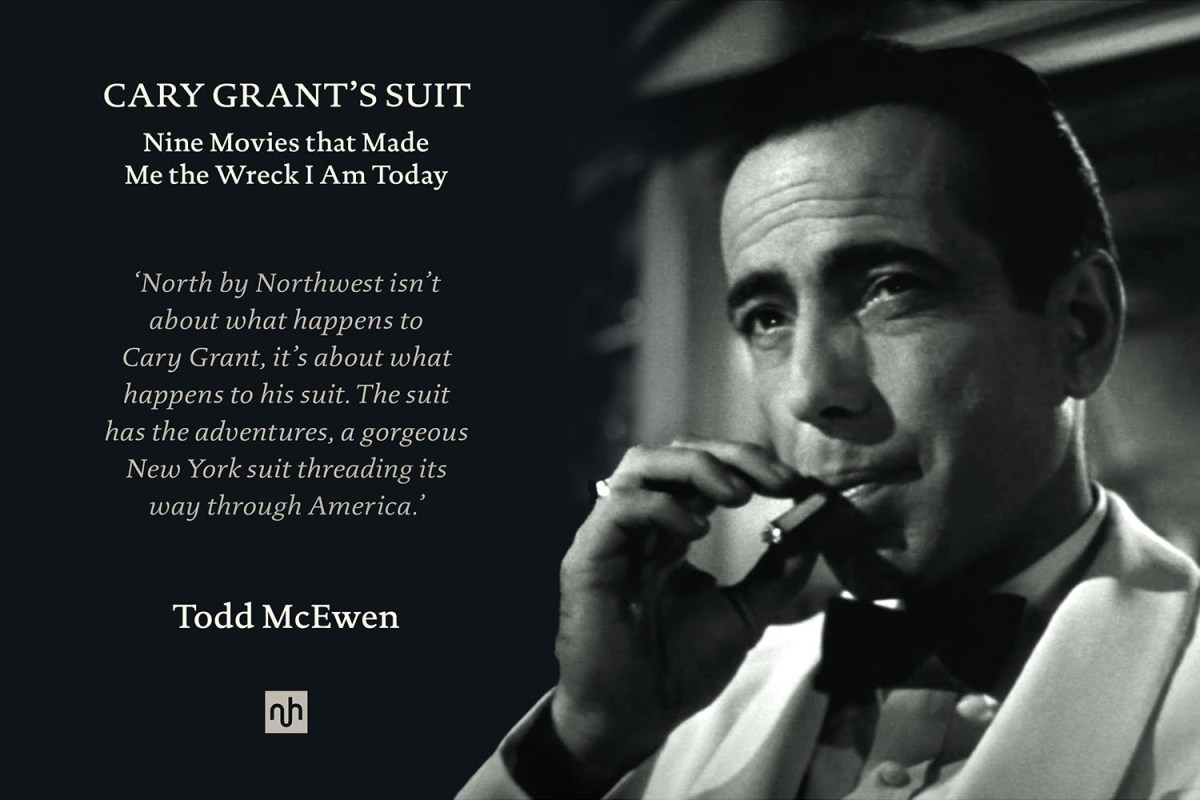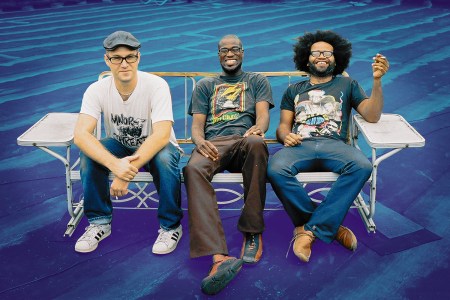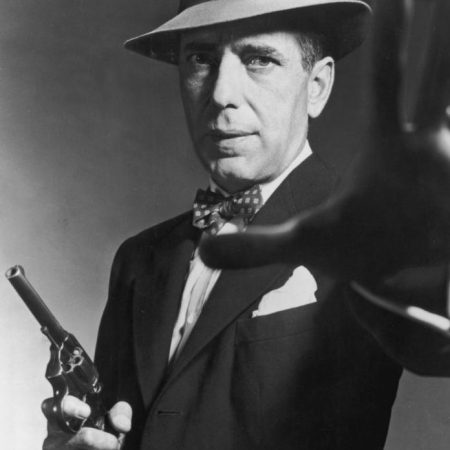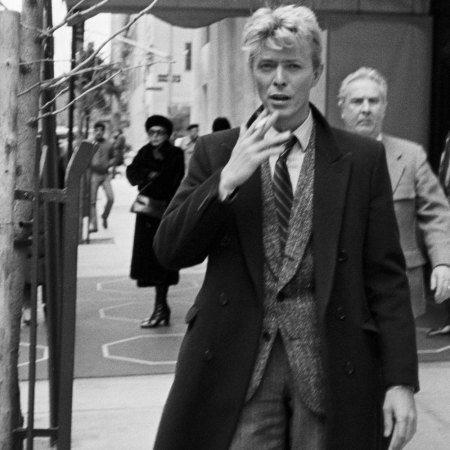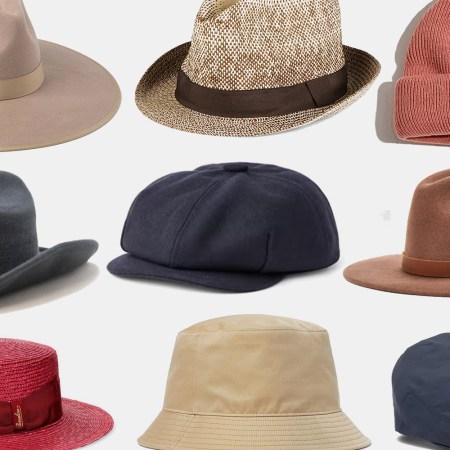Under the right conditions, movies can change the way we see the world and ourselves. But what happens when the changes that movies spark aren’t always for the best? The subtitle of Todd McEwen’s new book Cary Grant’s Suit: Nine Movies That Made Me the Wreck I Am Today offers one way of looking at that — a collection of essays tracing the author’s mishaps to the films he saw during his formative years.
In this excerpt from the book, McEwen revisits an especially memorable screening of Casablanca — and offers a novel theory about just why Humphrey Bogart is so appealing in the film in question.
Casablanca
Is there anything worse than being a nineteen year old romantic? I sincerely doubt it and I sincerely pity me. In the middle ages one viewed romance as a help in life. Courtly love ensured that at least some parts of society ran smoothly. But that was before the movies, television, and Hugh Hefner. It probably wouldn’t work now, but maybe we should try it.
Got romance from books of course but Casablanca didn’t help. Being romantic took me to Manhattan, then brought me to Scotland, then back to America, and then Scotland. Scotland still isn’t really as romantic to me as New York. I’ve been doing this my whole life, now that I think about it, and it’s crazy.
The amount of jet fuel alone is embarrassing, never mind what I was actually doing with my existence.
Yes, I am a self-wrecker.
Being a romantic made me follow V. down the stairs at the office because I thought her pink Converse hi-tops meant we were to be together. It once made me get very out of control on the Staten Island Ferry, saying the dumbest things I’ve ever heard to a girl I barely knew — then to invade her apartment and get too sozzled on Cointreau to leave.
Romance insists I suspend a tassel from the scroll of my very unremarkable violin, which I can’t play for beans. So it’s a hindrance, not a help, take it from me. It does mean that I am willing to listen to the romantic stories of others, but actually I don’t know any other romantics. Everyone I know seems more like an elevator, or a calculator.
But I had this girlfriend and I was going to try to impress her. I, this cesspool of callowness and sperm from California. She was from New Jersey. Her father was a printer, a profession I always held in respect; he wore turtlenecks and liked Tosca and things like that. When I look back it floors me, my naïveté and gaucherie and how generally awful I was.
One of the few advantages I had in intellectual parley with my girl was my movie chops. I found out she’d never seen Casablanca and I rubbed it in. Just enough. So here we were on upper Broadway on a warm night. I was wearing the absurd antiromantic wine-coloured double-knit trousers that followed me through college. I couldn’t get rid of them.
“Meet Me in the Bathroom” Doc Chronicles the End of an Era for the Music Industry
Directors Dylan Southern and Will Lovelace on how they brought Lizzy Goodman’s tale of early-aughts NYC rock to the big screenShe didn’t know much about movies and since I had grown up with very little else in my head I thought that this, this was where I would strike.
We had fooled around pretty heavily in the Museum of Modern Art’s screening room, during On the Avenue with Dick Powell. In Casablanca we didn’t fool around — I wanted her to see it, after all, because it’s romantic. It’s also horny as hell, though — what I call the Bottle Scene, when Ingrid comes back after the cafe is closed. It’s dominated by a big bottle of bourbon in the foreground, bigger than everyone, and Humphrey drinks most of it. How brimming everything is.
Believe it or not, in the late sixties and early seventies cinema-going was just re-emerging as a cool or even acceptable thing to do (to take an interest in it, as opposed to merely going to the movies). Woody Allen did a lot to promote the idea of lots of film as a necessary and usual part of life — he showed people standing in line at the New Yorker cinema, in a movie, which was inspiring.
But going to the movies in New York felt weird, after suburbia. They sell the same Mason Dots and all that, but you never feel quite as protected, or diverted, in a New York cinema as you do in the Fox Fullerton or an LA movie palace. The streets are too close. And New Yorkers, may the gods bless them, are more matter-of-fact about going to the pictures. It’s just one item on their vast list of daily rights.
The exception, of course, is Radio City Music Hall, which envelops, cradles, hypnotizes and suckles you so completely it’s like being in a wonderful expensive coffin of velvet and black marble and gold. It’s like being Lenin in his mausoleum, only with the Rockettes.
I’ve spent some of the most important days of my life in the west eighties and nineties. You wouldn’t call it one of the romantic neighbourhoods of Manhattan, but a lot happened to me there. The Thalia cinema was on West 95th — it’s gone now, or rather it’s been absorbed by a general arts centre next door. It smelled a little funny to a Californian nose. I don’t think my girl had been to the Thalia before that night.
I can tell you the truth: I didn’t know much about Casablanca either. We knew it was cool, though — there were just as many Humphrey Bogart posters in the dormitories as there were of that photograph of the Marx Brothers with a hookah, or reproductions of Toulouse-Lautrecs and Van Goghs and Rousseaus. Lots of things were being rediscovered as cool, as opposed to now, where it seems that just everything is cool, no question. Even downtown Milwaukee, Wisconsin. They all insist on its retro coolness.
When you’re young Casablanca strikes you as a romance with some solid Hollywood politics thrown in. But you could say it’s propaganda, or even a war movie with Ingrid Bergman floating on top. It’s a movie that looks like it’s going to lose itself, then comes back strong in the last reel, and there aren’t many pictures that pull that off. Once a movie has set itself adrift, it usually disappears over the horizon.
Casablanca doesn’t contain the whole world. Au Hasard Balthazar it isn’t, but it has tragedy, comedy, love and death enough for a summer evening, and it has these things in rather genuine ways that can be deceiving, under the monochrome quilt that it tucks under your chin.
There are many things to like about Casablanca; not the stuff that everybody likes, but secret, sweet things. One, perhaps, is that the writers were making it up as they went along. That’s sort of how we felt about everything in the Seventies anyway. There’s the big dark clayey globe in the beginning, the narrator of the prologue who says ‘Wiwld waw,’ the animated bumps of the embarkation points on the map.
There’s the little brandy glass Carl has in his pocket. The textiles dealer holding the price card in his hand, at the corner of the lace he’s trying to sell to Ingrid. The range of official fezzes. Water pipes and Turkish coffee pots. Sydney Greenstreet’s fly-swatter: there’s a deal of punctuation and symbolism in that. The way he uses it and when. The look of the documents. The caviar in its special bowl of ice, the odd telephone in the hangar — a phone with a roof — almost as weird as the miniature Eiffel Tower that holds glassware in the ‘Belle Aurore’.
Peter Lorre, in macassar oil and a dinner jacket that fits, nimble with his drinks and cigarettes, delivering some of the best lines ever written. You despise me, don’t you? The way Lorre and S.Z. Sakall and Paul Henreid talk — the way they all talk! Ingrid Bergman’s delivery. The diction, the almost unfair, sinister vocal clarity of the thing.
The small, winsome lights embedded in the concrete of the runway, in the last scene. It’s amazing that little winsome lights on the ground in fog didn’t become the norm for scenes of brave romantic sacrifice.
The resemblance of the interiors of Rick’s Cafe Américain and Lundy Brothers’ fish restaurant in Sheepshead Bay, Brooklyn. Arches. Adobe, or whatever they call it in Morocco. Moorish plastering. Big rooms with oriental chandeliers giving off dappled light, imbuing the finnan haddie at $3.35 with real nuance. At least a year before I discovered that I actually liked to eat fish, and could barely gag it down, I’d get on the B train anytime in order to eat lunch in that surrogate Rick’s.
total ‘marseillaise’ throat lump.
There’s no denying that this occurs — it’s medically recognized. People often present themselves at emergency rooms watery-eyed and unable to speak after a showing of Casablanca. Doctors know this is due not to the ‘We’ll always have Paris’ stuff, but to the moment when the Nazis are singing Watch on the Rhine and Paul Henreid steps up to the band and orders them to play the ‘Marseillaise’. Max Steiner engineered this intuitive, Charles Ivesian disturbing meld of the two anthems.
There are many achievements of France — wines from the Loire, Braille, roux, Renoir and diacritical marks all come to mind — but perhaps the incontestable French accomplishment is that everyone in every country in the world gets a lump in the throat and starts to blub when they hear the ‘Marseillaise’. Casablanca may have something to do with that, but it wouldn’t have been in the movie if its makers didn’t already know that it was like suddenly slicing a Bermuda onion right on your face.
One feels doubly stirred — it’s important to save Warner Brothers and France.
My great-great uncle Zephyr died of ‘Marseillaise’ Throat Lump at a France-America Friendship Day in Omaha, Nebraska in 1926. He was of French extraction, but several others also succumbed.
That many national anthems are total crap helps. You could say that the ‘Marseillaise’ was one of the great secret weapons of the war. It was stored in a bomb proof vault in Hollywood, and they knew just when to use it.
Last year I went through a phase of listening to the ‘Internationale’ while struggling to wake up in the morning and make breakfast. I thought it would buck me up, and it’s not bad. But I came back to the ‘Marseillaise’. You can squeeze grapefruit to it. Even if you won’t be able to swallow your egg.
I wish I still smoked. However, there’s nothing to smoke. Rick and Louis and Ugarte and Victor all got to smoke Camels, Gauloises and Dimitrinos from the look of things. Casablanca is a whirpool of tobacco smoke, champagne, bourbon and cognac. The eroticism of its smoke drifts through almost every shot.
2 Décembre 1941. That’s the date on the chit we see Rick sign when we finally get in to the cafe. On the table is an empty champagne saucer — his hand taps a bishop — he’s playing chess with himself and smoking — then we see him.
Bogart drinks and smokes more than everyone else in Casablanca. He smokes for us all. During the picture he smokes about twenty-one cigarettes — that last one is quite something and I’ll get back to it. (You don’t always see the cigarettes being lit, so I’m going roughly by length.) The continuity people were pretty good and that must have meant that Humphrey got to light up more than necessary. He’d have liked that.
Peter Lorre, surprisingly, smokes only three or four cigarettes, but he’s not around very long. He’s smoking almost the whole time he’s on camera. Very few actors ever got as much out of a cigarette — watch him smoke in The Maltese Falcon.
The other cigarette pro is Paul Henreid. He should have copyrighted that double whammy he used to enchant Bette Davis in Now, Voyager. Instead he selflessly offered it to all mankind. In Casablanca he smokes ten to Bogart’s twenty. You keep expecting him to ‘Bette’ his cigarettes with Ilsa but he restrains himself; anyway Ilsa doesn’t smoke so it would have been pretty funny if he kept doing that. He smokes alone, so that we see his beautiful hands.
Claude Rains smokes seven cigarettes on screen. He’s a casually elegant smoker, of course. He smokes in easy moments, to be dapper, rather than when things are tough. Sam is seen to have a couple of cigarettes smouldering in an ashtray on top of his piano; Carl smokes a cigarette after business hours, when he’s doing the accounts. Sydney Greenstreet smokes a cigar, in the Blue Parrot, with an air that suggests it’s usual with him. He doesn’t have to be elegant.
Conrad Veidt rarely has a cigarette, but when he does he smokes it right down to the end of civilization.
Through the smoke you can just see the plot shimmer like a mirage in fumes of alcohol. This too is pleasant, though you wonder if in 1941 there really was that much western liquor in Morocco. Of course booze goes where it’s needed. Everybody in Rick’s is engaged in Moorish plastering. Rick has nine or ten drinks. One of them is pretty much a whole bottle of bourbon. He’s upset. Predictably, Victor Laszlo is in second place, as you would expect of the unelected leader of the free world, with six drinks and an iced coffee. (When Victor and Ilsa first come into Rick’s, they sit down and Victor asks for two Cointreaus, the same stunt he pulls on Bette in Now, Voyager! Does he always push Cointreau on women?)
Ilsa matches him pretty closely with five drinks, although she is rarely seen to drink them. She’s so pure. We get it. (She likes that iced coffee of Sydney’s, though — she says she will miss it in America. Is this some kind of snide screenwriters’ impugning of coffee in America, maybe specifically coffee in Los Angeles? I hope so.) Claude Rains has five drinks, but as with his smoking it’s more a matter of style and gesture. Louis likes women, not drink. Before he’s arrested Peter Lorre probably has three or four drinks, Sam has maybe two, and Carl has a small brandy with the elderly German couple.
It’s Glassware v Nazis
Everybody drinks, and because it’s Warner Brothers there’s glassware to match. Cognac glasses, champagne saucers, little brandy ponies (like the one in Carl’s pocket), some ugly cut glass shot glasses in Rick’s office, an important brandy glass that Rick sets upright after the disturbance of Ugarte’s arrest. The ‘two Cointreaus’ come in amazingly small little conical glasses, while the Champagne cocktails arrive in schooners, it seems. There are even American shot glasses, for bourbon, at the Blue Parrot!
There are two points awash in only Champagne: the flashback to Rick and Ilsa’s affair in Paris, and any table where the Nazis gather. Louis, the swine, has recommended Veuve Cliquot. Yvonne’s rogue Nazi is drinking Champagne too. The Nazis know they’ve destroyed Europe and they’re drinking up what’s left of it fast.
But glassware becomes unimportant as the four main characters are drawn back into the global struggle. Perhaps the only drink casually tossed back is a shot of something in a highball glass Rick gives Victor after he’s escaped from the raid (behind them is a colossal fortification of assorted barware: alcohol has been a bulwark against the Germans). In fact that’s the last glass of anything in Casablanca, except for the grubby tumbler of Vichy water which Louis decides not to drink.
Counting the drinks says more about Hollywood than it does about French Morocco, or even World War II. Drinking and smoking added a lot to atmosphere in movies. Alcohol makes things look as if everyone’s rich and/or desperate; smoking gave actors a whole repertoire of gesture and nuance they hadn’t had before, and that photographed strikingly. And they don’t have these opportunities now.
Paul Henreid, Bette Davis, Humphrey Bogart or Peter Lorre smoking anything.
The first part of Casablanca is a descent into hell, the confused and corrupt situation the refugees are in, mirrored in the social strata and the layers of smoke in Rick’s. Everyone’s given up. The tobacco smoke and the booze help to obscure the light of reality. Humphrey’s the most bummed-out of the bunch and he’s socking everything away, surrounding himself with a toxic vapour because that’s what it feels like in his head. But then when he’s slapped awake, as it were, by Ilsa’s arrival in Casablanca, and he decides to do something about her, he begins to emerge from his poisonous cloud. He sobers. He refuses Sydney’s bourbon at the Blue Parrot — he even drinks coffee (the drink Ilsa prefers). When we find him studying the letters of transit, he isn’t even smoking! He doesn’t smoke again until Victor and Ilsa are on the plane. Then he allows himself a luxurious ‘post-coital’ cigarette; he’s just had an underground political orgasm.
He doesn’t offer one to Louis. Louis is too cynical. It’s not ‘black and white’, unless you watch it on television. In real life, Casablanca and so many of those Warner Brothers dramas are a shifting, seductive spectrum of smooth, deep blacks, ivories and crème de cafes. The intense sunlight (Californian, of course, but say it’s like Morocco) is the glare of the harsh world, the world of war everyone’s trying to shun. The life desired takes place indoors, mainly at night, when these beleaguered people can say what it is that they want.
The sunlight let Michael Curtiz play with chiaroscuro. The sun is filtered through venetian blinds and jalousies, making patterns of bars and stripes fall on the action. Everyone’s in jail. This isn’t a motif pushed to its perfect yet infernal limit as Douglas Sirk used to do. In Sirk pictures there are so many physical symbols, so many things in the way, so many flowers and decorative screens and menacing vases, that by the end of the movie the actors have to pick their way around the sets and the script like they’re in a junk shop.
What the stripes say (they’re also on Ilsa’s blouse, and the cage-like grid of bamboo poles above her at the market) is that nothing is black and white. Stripes are actually a gray area of existence, not this or that for long. Like the desires of those in Rick’s, in Casablanca itself, like the meaning of Vichy. And when the fog of confusion and dishonesty and war envelops the airport and the murder of Strasser, and Victor and Ilsa fly into the future, Rick and Louis are clearing their heads. Now they know what to do. And that’s romantic.
I didn’t think my girlfriend was enjoying it much, though she laughed at the line about not invading certain parts of New York — everybody did. It’s one of the reasons you go to see Casablanca in New York. I wanted her to like it, though, because then we’d have something to share. So we stuffed ourselves into this big ice cream sandwich of a movie.
Once she clicked her tongue and said she thought something corny. It probably was, though now it drives me crazy — what could it have been? Rick helping the Bulgarian couple? What??
All was not well there in the Thalia that evening. Granted this was 1972 and Casablanca was just coming back into its own, but this was the worst print of anything I’d ever seen. One in four lines of dialogue was missing or made absurd by evisceration — often there would be that ominous fluttering sound after a splice goes through the gate and lifts the film off the sound drum, so the next few words sound like someone has slammed a door on you in the middle of an argument. There were blisters, bits from other prints cut in — it got worse and worse and worse. We weren’t exactly enjoying the visual luxuriance I described earlier. It was like reading a good book from a library that’s covered in old fashioned Scotch tape, coffee stains, foxing and with some of the corners torn off. Yes, it’s all there, but it messes with your head while you’re trying to love it.
I once had a used copy of the Norton Modern Poems edited by Ellmann and O’Clair. On the page where I was trying to read Wallace Stevens’s Anecdote of the Jar, two students in a classroom had been writing notes to each other in the margin:
My pussy sheds.
Not my problem!!!
Is what I’m talking about.
What Quentin Tarantino’s List of “Perfect” Films Reveals About Youth and Moviegoing
Are we all biased towards the movies that came out when we were young?So in the Thalia that night there was brooding, serious unrest about the quality of the print. A jungle drums level of trouble. Most of the people in the Thalia seemed to be guys in their mid twenties with tinted glasses and beards — film buffs — a few had girlfriends in loose dresses. They all looked stoned and at one moment I wondered if this was what happened to you if you went to the movies too much. We were still so. . .clean.
Isn’t this the rarest type of discomfiture? Trying to enjoy something you like, with someone you like or maybe even love, and it’s not working out? Even though it’s dark, you see them looking skeptical.
But now came the coup de grâce, and the reason I hardly ever went back to the Thalia and didn’t weep at its demise along with the New York Times, for this is how this print of Casablanca ended:
renault: Major Strasser has been shot. Round up the usual suspects.
cut to ‘marseillaise’. end title.
girlfriend: Hey, what kind of an ending do you call that?
me: But –
No Hill of Beans, no Beautiful Friendship, no NOTHIN’. cut back to thalia theater, int. The film buffs were going nuts, yelling, screaming, tearing their hair out. Some of them were standing on the seats, shaking their fists at the projection room, the girlfriends clawing at their combat jackets. Mason Dots were being thrown. The house lights were coming up very slowly, as if the little cinema was itself waking to disaster or war. Ask for your money back? How would that compensate you for Casablanca being forever herniated?
We left the buffs to their war and bald spots and went out onto Broadway. It was hot and we walked past the supermarket where in The Odd Couple Walter Matthau whacks chocolate ice cream all over Jack Lemmon’s Brooks Brothers ‘Tropical Weight’ suit.
I was looking for little winsome lights on the ground — it wasn’t going to work out. I didn’t know it then, but I was terribly much not what these people wanted for their daughter. Later on there was a terrible argument at the George Washington Bridge. There was an I Can’t Marry You moment in a Volkswagen beetle (hers, and yes, hers). She got rid of me and I don’t blame her. I noticed I was going around in Bogartian deeps. It’s the question about Scotland and Calvinism — which needed the other more? Was I bitter in my love life before I encountered Humphrey Bogart, or did he school me in it?
Rick overcame all this male pain — he found a way to live with it. Someone hurts you like this, you drink and smoke. You learn to play chess by yourself. I began to see my girlfriend’s father as my Victor Laszlo. I did lose out. But we’d always have Englewood Cliffs.
It’s not wanting to be tough like Humphrey Bogart, it’s wanting to be sad like Humphrey Bogart.
Excerpted from Cary Grant’s Suit: Nine Movies That Made Me the Wreck I Am Today by Todd McEwen. Published with permission from Notting Hill Editions.
This article appeared in an InsideHook newsletter. Sign up for free to get more on travel, wellness, style, drinking, and culture.
